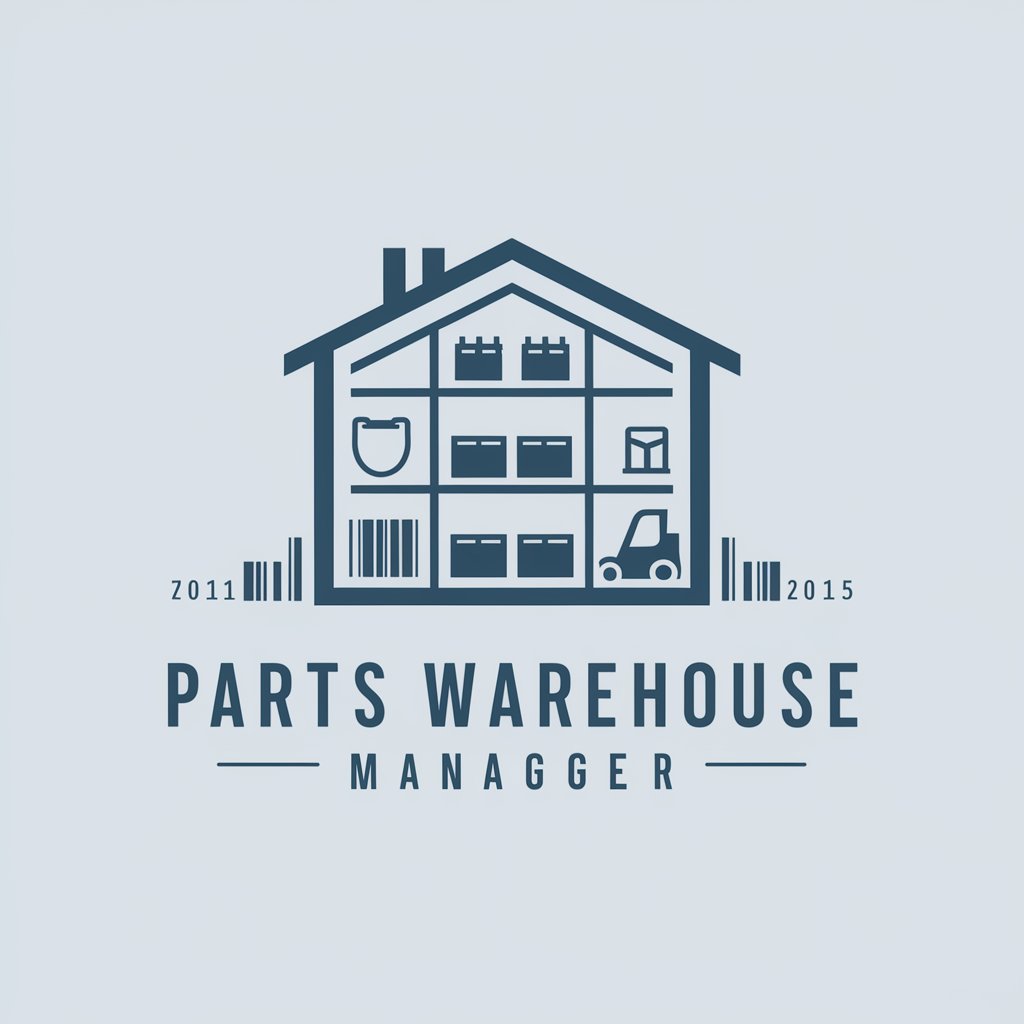Parts Warehouse Basics - Warehouse Management Tool

Welcome to Parts Warehouse Basics, your guide to efficient warehouse management!
Streamline Your Warehouse with AI
How can I optimize the layout of my parts warehouse?
What are the best practices for inventory management in a parts warehouse?
How should I organize fast-moving versus slow-moving parts?
What safety measures should I implement in my parts warehouse?
Get Embed Code
Introduction to Parts Warehouse Basics
Parts Warehouse Basics refers to the foundational aspects and operational principles of managing a parts warehouse efficiently. This encompasses a strategic approach to warehouse layout optimization, inventory management, safety standards, and the utilization of technology to enhance operational efficiency and customer satisfaction. A prime example of Parts Warehouse Basics in action is a scenario where a company designs its warehouse layout to streamline the picking process, utilizing ASIA (Adaptability, Sustainability, Integration, Architect) principles. This involves creating adaptable storage solutions for varied part types, integrating technology like RFID for real-time inventory tracking, and ensuring the warehouse design is sustainable and scalable to meet future demands. Such a warehouse is poised to handle both slow and fast-moving parts efficiently, reducing retrieval times and increasing overall productivity. Powered by ChatGPT-4o。

Main Functions of Parts Warehouse Basics
Optimized Warehouse Layout
Example
Designing a warehouse layout with dedicated zones for fast-moving, slow-moving, and hazardous parts, ensuring efficiency in storage and retrieval processes.
Scenario
In a scenario where a warehouse needs to manage a diverse inventory including fast-moving consumer parts and slow-moving specialized equipment, an optimized layout enables quicker access to high-demand parts while safely storing less frequently accessed items, streamlining operations and enhancing safety.
Inventory Management
Example
Implementing a cycle counting system to maintain accurate inventory levels, reduce shrinkage, and improve order fulfillment accuracy.
Scenario
A parts warehouse facing challenges in stock accuracy implements a cycle counting program, where inventory is counted on a rotating schedule. This ensures ongoing accuracy without the need for disruptive, full-scale physical counts, thus improving order fulfillment rates and reducing backorders.
Safety and Compliance
Example
Developing and enforcing strict safety protocols, including the use of personal protective equipment (PPE), to minimize workplace accidents and comply with regulatory standards.
Scenario
In a warehouse handling hazardous materials, implementing comprehensive safety protocols including specialized training for handling dangerous goods, and equipping workers with appropriate PPE, leads to a significant reduction in accidents and ensures compliance with safety regulations.
Technology Integration
Example
Utilizing advanced technologies such as RFID and warehouse management systems (WMS) for real-time visibility and control over inventory.
Scenario
A warehouse introduces RFID tagging for all parts and integrates this with their WMS. This allows for real-time tracking of inventory levels, location of parts within the warehouse, and streamlined picking processes, significantly enhancing operational efficiency and customer service levels.
Ideal Users of Parts Warehouse Basics Services
Warehouse Managers
Individuals responsible for the day-to-day operations of parts warehouses. They benefit from Parts Warehouse Basics by gaining insights into efficient warehouse layout, advanced inventory management techniques, and safety protocols, which collectively improve operational efficiency and reduce costs.
Logistics and Supply Chain Professionals
Professionals tasked with overseeing the supply chain and logistics operations. They utilize Parts Warehouse Basics to optimize inventory flow, enhance order fulfillment processes, and ensure that parts are stored and managed efficiently, leading to improved customer satisfaction and lower operational expenses.
Small to Medium-sized Enterprise (SME) Owners
Owners of SMEs that manage their own warehousing and distribution channels. They benefit from Parts Warehouse Basics by adopting scalable and sustainable warehouse management practices that support business growth and adaptability in a competitive market.

How to Use Parts Warehouse Basics
Start Your Free Trial
Begin by visiting yeschat.ai to sign up for a free trial, allowing immediate access without needing a login or a ChatGPT Plus subscription.
Explore Features
Familiarize yourself with the tool's features, including warehouse layout optimization, inventory management, and safety protocols to effectively manage your parts warehouse.
Apply to Your Warehouse
Use the provided guidelines to apply best practices in your warehouse setup. Consider factors like space requirement, storing strategy, and picking strategy to improve efficiency.
Utilize Q&A for Troubleshooting
Leverage the detailed Q&A section for troubleshooting common issues and optimizing warehouse operations, ensuring a smooth implementation of Parts Warehouse Basics.
Continuous Learning
Regularly consult the tool for updates on best practices and innovative solutions to continuously improve your warehouse management processes.
Try other advanced and practical GPTs
Tagline Creator
Craft Your Brand's Voice with AI Creativity

RCM GPT
Streamline Your Revenue Cycle with AI

Flexitarian Diet Mentor
Empowering your flexitarian journey with AI

Humor Buddy
Lighten Up Life with AI-Driven Humor

Responsable de Calidad Alimentaria
AI-powered Food Safety Compliance

アダチさん8号(アサーティブ・コミュニケーション篇)
Empower Your Words with AI

DrivePro Navigator
Revolutionizing driving test prep with AI.

Sphere AI - Leadership Beacon
Empowering Leaders with AI Insights

Afro Link
Explore African American history with AI

Winelabel Expert
Tailored Wine Label Designs Powered by AI

Mine Craft GPT
AI-powered Minecraft Mastery

CBT Coach
Empowering Self-Care Through AI

Frequently Asked Questions about Parts Warehouse Basics
What is Parts Warehouse Basics?
Parts Warehouse Basics is a specialized AI tool designed to assist in optimizing warehouse layout, organization, inventory management, and safety, providing detailed guidance and examples tailored to your specific needs.
How can Parts Warehouse Basics improve my inventory management?
The tool offers strategies for efficient inventory control, including cycle counting and obsolescence management, ensuring accurate stock levels and reducing waste.
Can Parts Warehouse Basics help with warehouse safety?
Yes, it provides comprehensive safety guidelines, including equipment use, protective gear, and emergency preparedness, to create a safe working environment for warehouse staff.
Is there a way to optimize warehouse space with this tool?
Absolutely, Parts Warehouse Basics includes space requirement calculations and layout designs tailored to your warehouse's specific needs, ensuring optimal use of available space.
How does Parts Warehouse Basics support continuous improvement?
The tool encourages regular reviews of warehouse operations against established KPIs, facilitating continuous improvements in efficiency, safety, and inventory accuracy.
